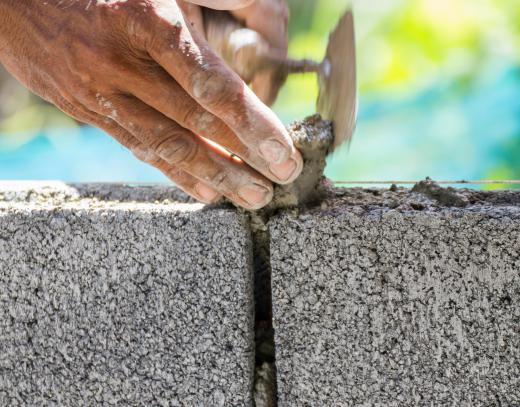What is Hydrated Lime?
Hydrated lime is a type of dry powder made from limestone. It is created by adding water to quicklime in order to turn oxides into hydroxides. Combined with water and sand or cement, hydrated lime is most often used to make mortars and plasters. Its chemical name is calcium hydroxide, or Ca(OH)2.
When making hydrated lime, a manufacturer must first make quicklime. Quicklime is made directly from the calcination in raw limestone by the process of calcining and consists of calcium oxide and magnesium oxide. In this process, limestone is first broken up to reduce its size. Then it is washed and taken to kilns to be heated through a three step process: preheating, calcining, and cooling. Once cooled, the quicklime is crushed and then water is added.

Depending on the production method, high-calcium or dolomite hydrated lime can be created. Dolomite hydrated lime may be created under normal atmospheric pressure or under high pressure. The different processes produce different percentages of water, calcium, and magnesium in the finished lime. In high-pressure procedures all the magnesium and calcium is hydrated, whereas in normal pressure processes only part of the magnesium and calcium is hydrated.

There are several classes of hydrated lime. Type S and Type SA denote special high-purity limes and are most often used in mortars. Types N and NA denote normal limes and are not cleared for use in building materials but may be used in asphalt and paper production. Type SA and NA are aerated limes, so their structure is more porous than their non-aerated counterparts.

Hydrated limes are classified by the amount of water they retain and their maximum air content. S types retain 85 percent water, N types 75 percent. NA and SA types are classified as having a maximum air content of 14 percent, and N and S types have seven percent air content.
Also called slaked lime, hydrated lime is a good bonding agent and is watertight. It is also strongly alkaline, having a pH of 12.4. For this reason, it can be used to neutralize acid, in water and sewage treatment, and to stabilize soil. This also means it will cause skin and eye irritation if it comes in contact with the body, and inhalation of dust may cause health problems. Gloves, eye protection, and masks should be worn at all times when working with these substances.
AS FEATURED ON:
AS FEATURED ON:













Discussion Comments
I have been told that I can use hydrated lime for a rust preventative. Does anyone know if that's true and if so how to best apply it? We are a concrete block manufacturer based in the Philippines and need an inexpensive method to treat the bolts we also manufacture for use with our patented pre-cast blocks.
@geekish - One of my favorite uses of limestone can still be seen on my lawn - I used limestone as an additive to the soil to help my grass seed grow!
You can add agricultural lime to your lawn as you add grass seed and it helps counteract acidity in the soil here in North Carolina.
I am originally from Virginia and not much of an agriculturalist, so I was lucky when I ran into a man who had lived in NC all his life (and in my neighborhood so he even knew the specifics of our neighborhood's soil) and he saw me trying to plant grass seed and he promised me up and down that I would have trouble unless I added the lime.
Let me tell you, I had so many neighbors asking how I grew my grass and told me all their horror stories of trying to grow grass, so I like to spread the tip so it might help someone else's lawn!
I am from Kentucky where we have a pretty decent amount of limestone so I grew up knowing that limestone makes for an amazing water purifier.
One of the more famous Kentucky bourbon brands likes to brag that the water it uses is very pure because it has been cleaned by limestone.
My aunts who still live in Kentucky also tell me that they have now opened old rock quarries where limestone is, and people go swimming in them and they even are places where people are trained in scuba diving. And they say the water is crystal clear!
It made me curious as to the other uses of this interesting stone, and I must say I never would have thought it was part of plastic making. Does anyone know of other uses?
Post your comments